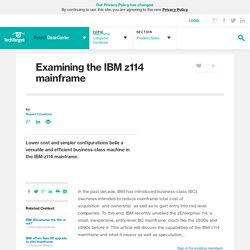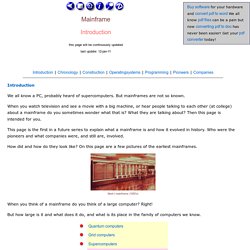

IBM Knowledge Center. Computer History. John Kopplin © 2002 The first computers were people!

That is, electronic computers (and the earlier mechanical computers) were given this name because they performed the work that had previously been assigned to people. "Computer" was originally a job title: it was used to describe those human beings (predominantly women) whose job it was to perform the repetitive calculations required to compute such things as navigational tables, tide charts, and planetary positions for astronomical almanacs. Imagine you had a job where hour after hour, day after day, you were to do nothing but compute multiplications. Boredom would quickly set in, leading to carelessness, leading to mistakes. This picture shows what were known as "counting tables" [photo courtesy IBM] A typical computer operation back when computers were people.
The abacus was an early aid for mathematical computations. A very old abacus A more modern abacus. An original set of Napier's Bones [photo courtesy IBM] What is a Mainframe? By Lance H.

Vaughan Reprinted here with his permission Having read John Campbell's "What is a Mainframe", and having been asked this question myself many times I would like to propose a more illuminating definition. First, however, some very brief biographical info. I first became interested in computing machines as a teenager. In those days the 2nd generation was rapidly drawing to a close and System/360 was about to change the computing landscape. One might suppose that it would be easy to define a mainframe, but such is not the case. 1) it is completely unenlightening; and 2) it is misleading. IBM Knowledge Center. Can the mainframe remain relevant in the cloud and mobile era? The CICS (Customer Information Control System) application server, which runs on the IBM mainframe, processes 1.1m transactions per second, significantly more than the number of Google searches.

Yet the mainframe has remained largely unfashionable. On 7 April 1964, IBM unveiled its first mainframe, the System/360. Today, 80% of the world's corporate data is still managed by mainframes. IBM Hursley laboratory director Rob Lamb says: “There are 6,900 tweets, 30,000 Facebook likes and 60,000 Google searches per second. " The mainframe CICS runs 1.1m transactions per second, which equates to 10bn per day. These numbers illustrate the prevalence of the IBM mainframe, which for the last half a century has been the technological workhorse enabling government policy and business processes.
It has also kept up with the times, supporting modern programming environments based on Java and C++. Examining the IBM z114 mainframe. In the past decade, IBM has introduced business-class (BC) machines intended to reduce mainframe total cost of acquisition and ownership as well as to gain entry into mid-level companies.

To this end, IBM recently unveiled the zEnterprise 114; a small, inexpensive, entry-level BC mainframe, much like the z800s and z890s before it. This article will discuss the capabilities of the IBM z114 mainframe and what it means as well as speculation... about IBM’s ultimate intentions. An overview of the z114 mainframe As a BC machine, the z114 is a slower, smaller version of IBM’s enterprise-class (EC) z196 processor as shown in the table below. The table highlights some important mainframe jargon. You can see that the differences between the z114 and the z196 are dramatic. There are some interesting advantages to the z114 too. Can the mainframe remain relevant in the cloud and mobile era? System z - Parallel Sysplex. With IBM's Parallel Sysplex technology, you can harness the power of up to 32 z/OS systems, yet make these systems behave like a single, logical computing facility.

What's more, the underlying structure of the Parallel Sysplex remains virtually transparent to users, networks, applications, and even operations. To accomplish all this, the z/OS Parallel Sysplex combines two critical capabilities: The first is parallel processing, and the second is enabling read/write data sharing across multiple systems with full data integrity. This combination makes the z/OS Parallel Sysplex unique among every other system, solution, or architecture available today. And, it results in a scalable growth path that extends beyond billions of instructions per second.
Read more Parallel Sysplex Benefits The true value of the z/OS Parallel Sysplex technology can be found in the business benefits it offers your enterprise. Parallel Sysplex Advantages With Parallel Sysplex technology advances and business prospers. Can the mainframe remain relevant in the cloud and mobile era? Mainframe. Introduction We all know a PC, probably heard of supercomputers.

But mainframes are not so known. When you watch television and see a movie with a big machine, or hear people talking to each other (at college) about a mainframe do you sometimes wonder what that is? What they are talking about? Then this page is intended for you. This page is the first in a future series to explain what a mainframe is and how it evolved in history. How did and how do they look like? When you think of a mainframe do you think of a large computer?